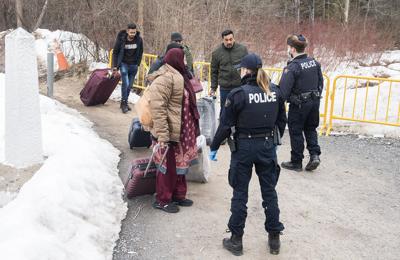
Trump was promised a crackdown at the border by Canada. Not as easy as it seems
At the U.S.-Canada border, a rural road ends with six concrete blocks that resemble Lego pieces. As it speeds through the snow, the police car comes to a halt.
Installed in August in collaboration with the administration of President Joe Biden, the barriers prevent cars carrying migrants from speeding across the border into the United States.
They do not, however, prevent migrants from crossing on foot.
According to Sergeant Daniel Dubois of the Royal Canadian Mounted Police (RCMP), “people can still hop over them.”
According to Canadian police, within the past four years, more cameras and sensors have been placed along this portion of the border. After U.S. President-elect Donald Trump threatened Canada and Mexico with sweeping 25% tariffs if they do not curb the flow of migrants and narcotics into the United States, Ottawa pledged this month to increase the number of police and equipment aimed at southbound border-crossers.
However, Canadian law enforcement officials admit that their ability to halt southbound migrants is limited.
“Even if we were everywhere, we couldn’t stop it,” Quebec RCMP spokesperson Charles Poirier stated.
According to data acquired by Reuters, in the 12 months ending in October, Canadian authorities turned back over 1,000 individuals attempting to enter Canada between official crossings, while U.S. Customs and Border Patrol arrested over 23,000 people on the U.S. side. Although the number of apprehensions of migrants headed for the United States increased from the previous year, they still only make up a small portion of the 1.5 million apprehensions that occurred during the same time period close to the U.S.-Mexico border, which sees a greater rate of irregular migration overall.
There has been recent southbound movement at the Canada-U.S. border. That might not be the case.
Number of migrants intercepted by U.S. Customs and Border Protection (CBP) along the Canada-U.S. border is displayed in a line graph.
Number of migrants intercepted by U.S. Customs and Border Protection (CBP) along the Canada-U.S. border is displayed in a line graph.
The number of individuals detained by Canadian police between ports of entry and returned to the United States between March 2023 and November 2024 is displayed in a line graph.
The number of individuals detained by Canadian police between ports of entry and returned to the United States between March 2023 and November 2024 is displayed in a line graph.
Politicians in Canada acknowledge that projecting a sense of security is one of the goals of the border display of force.
Reuters obtained a recording of Canada’s Immigration Minister Marc Miller saying, “We have a very important activity to undertake to make sure that we give confidence to the U.S. that we have an immigration system that they can manage for,” during a private meeting with the advocacy group Canadian Council for Refugees last month.
“I think we face a credibility challenge,” he continued.
An interview with Miller was not possible.
MONITORING THE LONGEST LAND BORDER IN THE WORLD
A portion of a 105-mile (170-kilometer) section of the border that is known for frequent migrant crossings was patrolled by RCMP officers for four hours. They were looking for tips from the public, calls from U.S. authorities, suspicious movement caught on surveillance cameras, and unpredictable drivers who might be carrying potential crossers.
It is an enormous undertaking to secure the world’s longest land border, which spans over 4,000 miles (6,400 km) and is made up of farmland, lakes, ditches, and forests. Additionally, Poirier stated that even if police detect a migrant’s intention to cross, they cannot arrest them while they are lawfully in Canada.
Four migration specialists contacted by Reuters expressed uncertainty about the effectiveness of the promised additional equipment and technology for border control in preventing crossings.
“Whether or not we would improve technological capabilities at the border is a topic of much discussion. Increased patrolling is a topic of much discussion. However, I believe that the main purpose of everything that has happened thus far is to demonstrate that we are paying attention to the border,” said Lama Mourad, an assistant professor at Carleton University’s Norman Paterson School of International Affairs.
Advocates for refugees contend that rather than discouraging immigration, the restrictions increase their risk. Since a 2023 rule change permitted each nation to reject asylum-seekers who were crossing between ports of entry, at least nine bodies have been discovered close to the Quebec-New York border.
“All you do is encourage people to take a chance,” stated Carlos Rojas Salazar, executive director of Action Refugees.
Requests for comment on Public Safety Minister Dominic LeBlanc’s border strategy were not immediately answered by his office, and he was not available for an interview.
According to some migration experts, it might be more successful to stop prospective migrants headed for the United States from ever entering Canada.
Although they were unable to provide an exact number, police told Reuters that they had detained individuals at the border who were traveling straight from the airport.
Earlier this year, Canada began turning away visa holders at points of entry and declining additional visas.
“It isn’t right that people should be able to get a visa under certain conditions, come here, claim asylum, or not, and then migrate in large amounts into the U.S. border, into the U.S,” Miller stated to the group of refugee supporters.
Mourad concurred that restricting the arrival of possible migrants might work. However, it’s not tangible in that sense—it’s not a wall or a helicopter. Therefore, I don’t know if that will work to persuade someone like Trump,” she remarked.
A request for comment from Trump’s transition staff was not answered.
CITIZEN MONITORING
To keep an eye on the wildlife, Terry Rowe, a resident of Champlain, New York, whose house is located roughly a mile from the Canadian border, installed six motion-sensing cameras on his property. In the end, he watched migrants.
He takes out his phone and plays a night vision film of a guy trundling across the snow with a rucksack, which lasts eight seconds.
He estimates that in the last three years, he has accumulated over 40 of these movies.
“These migrants are coming 72 feet from our bedroom window,” Rowe stated. “We’ve seen them shortcut across the front yard.”
He told Reuters that he frequently notifies the US Border Patrol of migrants who cross through his yard. They typically arrive in a matter of minutes for southbound crossers. Rowe remarked, “Going north not so much,”
According to Rowe, prizes for apprehensions were once offered by US officials. Residents are encouraged to report migrant crossings, according to Canadian authorities.
According to Rowe, the majority of traffic until last month came from Canada to the United States.
That might be going to change soon. According to Poirier, Canadian law enforcement is preparing for a possible surge of migrants escaping Trump’s pledge to carry out mass deportations once he takes office.
“We’ve redeployed some officers right here at the border to make sure that if there is a surge in migration, we’ll be ready for it,” he stated.
From Rowe’s point of view, that surge appears to be beginning already.
Four of the five people he has observed crossing recently have been heading north, he added.
“It’s reversed and I think it’s going to pick up.”
All Categories
Recent Posts
Tags
+13162306000
zoneyetu@yahoo.com



